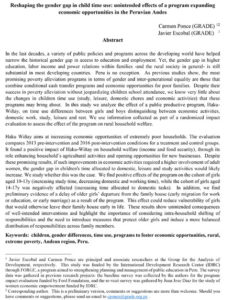Reshaping the gender gap in child time use: unintended effects of a program expanding economic opportunities in the Peruvian Andes
| Year | : | 2019 |
|---|---|---|
| Author/s | : | Carmen Ponce, Javier Escobal |
| Area/s | : | Education and learning, Methodologies for research and evaluation of policy and programmes, Poverty and equality |
Ponce, C. & J. Escobal (2019). Reshaping the gender gap in child time use: unintended effects of a program expanding economic opportunities in the Peruvian Andes.
In the last decades, a variety of public policies and programs across the developing world have helped narrow the historical gender gap in access to education and employment. Yet, the gender gap in higher education, labor income and power relations within families -and the rural society in general- is still substantial in most developing countries. Peru is no exception. As previous studies show, the most promising poverty alleviation programs in terms of gender and inter-generational equality are those that combine conditional cash transfer programs and economic opportunities for poor families. Despite their success in poverty alleviation without jeopardizing children school attendance, we know very little about the changes in children time use (study, leisure, domestic chores and economic activities) that these programs may bring about. In this study we analyze the effect of a public productive program, Haku-Wiñay, on time use differences between girls and boys distinguishing between economic activities, domestic work, study, leisure and rest. We use information collected as part of a randomized impact evaluation to assess the effect of the program on rural household welfare.
Haku Wiñay aims at increasing economic opportunities of extremely poor households. The evaluation compares 2013 pre-intervention and 2016 post-intervention conditions for a treatment and control groups. It found a positive impact of Haku-Wiñay on household welfare (income and food security), through its role enhancing household’s agricultural activities and opening opportunities for new businesses. Despite these promising results, if such improvements in economic activities required a higher involvement of adult women, the gender gap in children’s time allocated to domestic, leisure and study activities would likely increase. We study whether this was the case. We find positive effects of the program on the cohort of girls aged 10-13y (increasing study time, decreasing domestic and working time), while the cohort of girls aged 14-17y was negatively affected (increasing time allocated to domestic tasks). In addition, we find preliminary evidence of a delay of older girls’ departure from the family house (early migration for work or education, or early marriage) as a result of the program. This effect could reduce vulnerability of girls that would otherwise leave their family house early in life. These results show unintended consequences of well-intended interventions and highlight the importance of considering intra-household shifting of responsibilities and the need to introduce measures that protect older girls and induce a more balanced distribution of responsibilities across family members.







